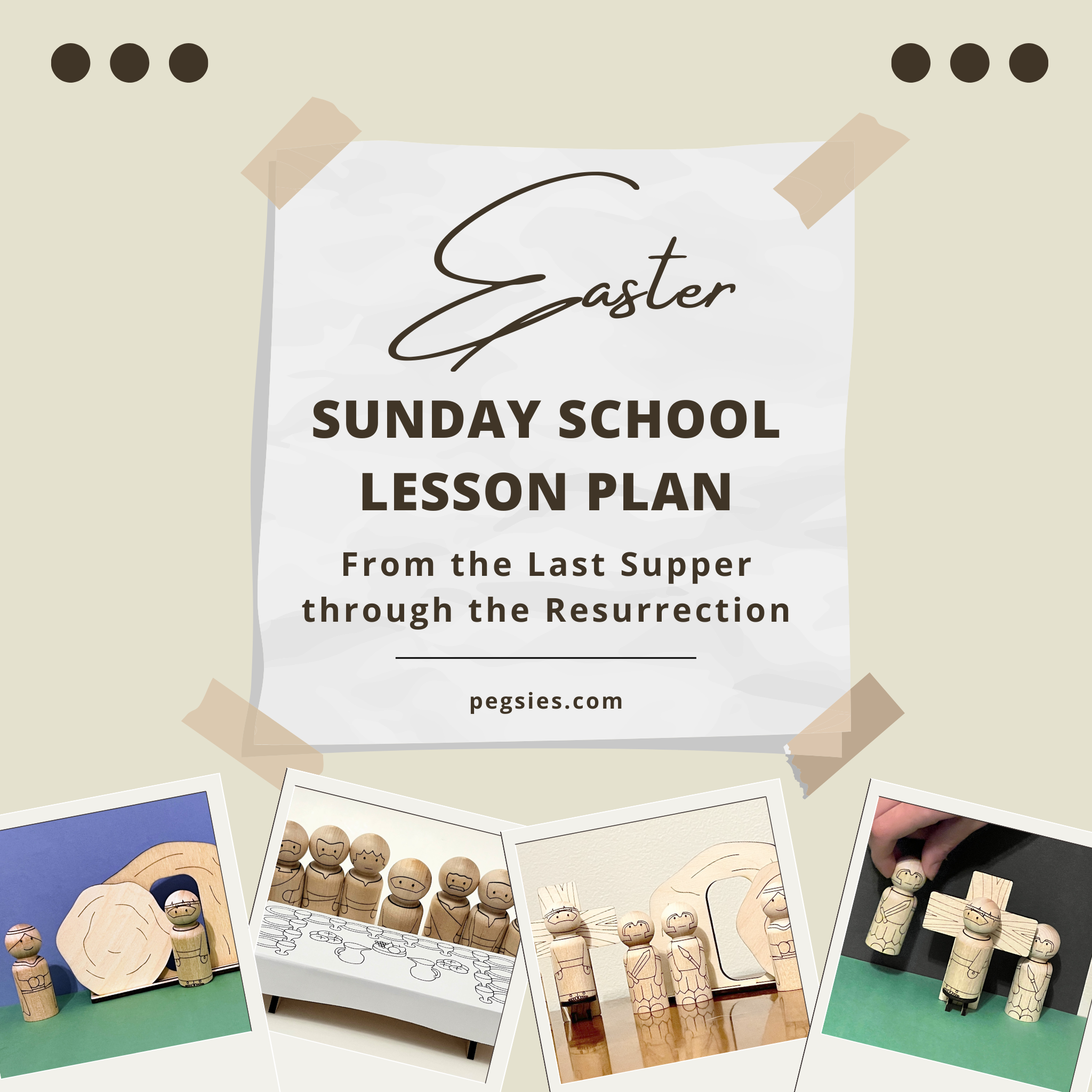
Objective: To help students understand the significance of the Last Supper and the events leading up to the Resurrection of Jesus Christ, using the Pegsies Easter Peg Doll Set and the Pegsies Last Supper Peg Doll Set as visual aids.
Recommended Age: Kids Elementary through Middle School
Materials:
- Pegsies Easter Peg Doll Set (and Coloring Page)
- Pegsies Last Supper Peg Doll Set (and Coloring Page)
- Bible
- Crayons, markers, or colored pencils
Lesson Outline:
Introduction (5 minutes)
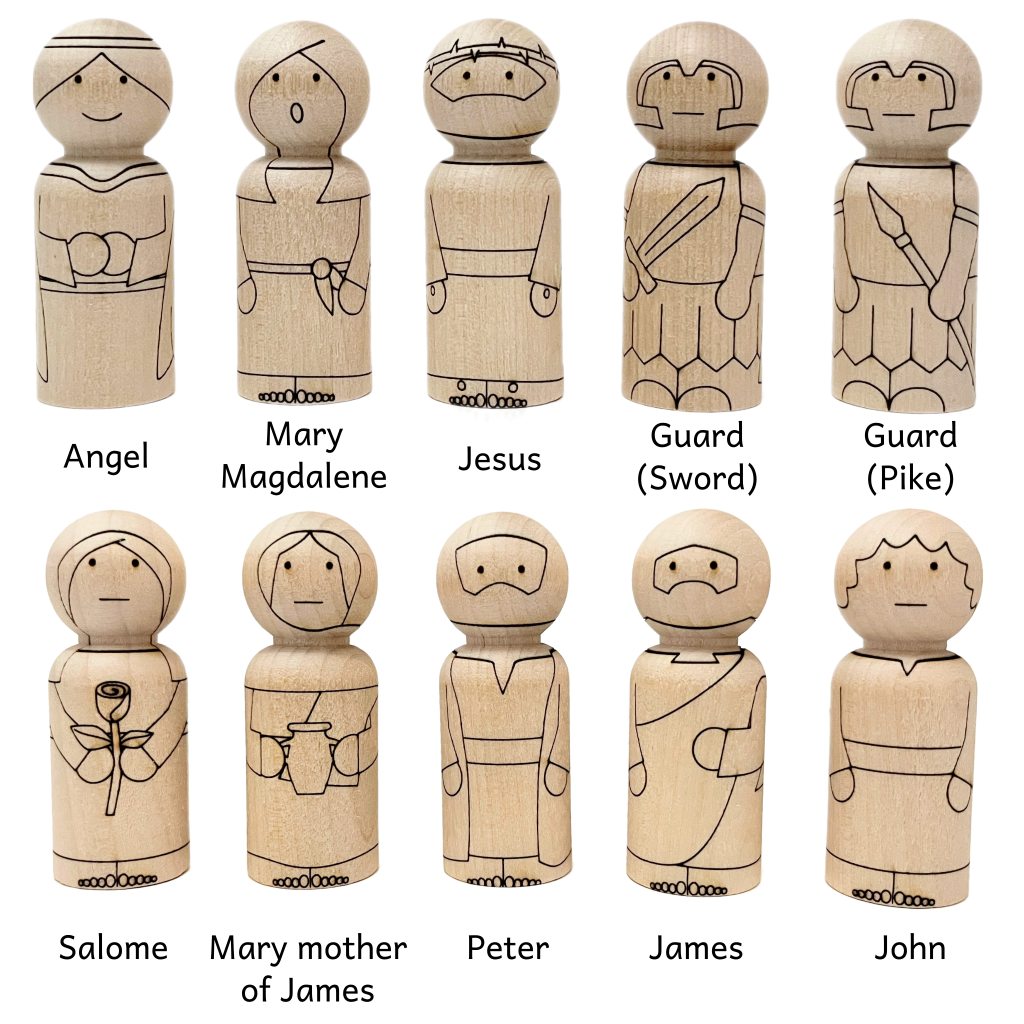
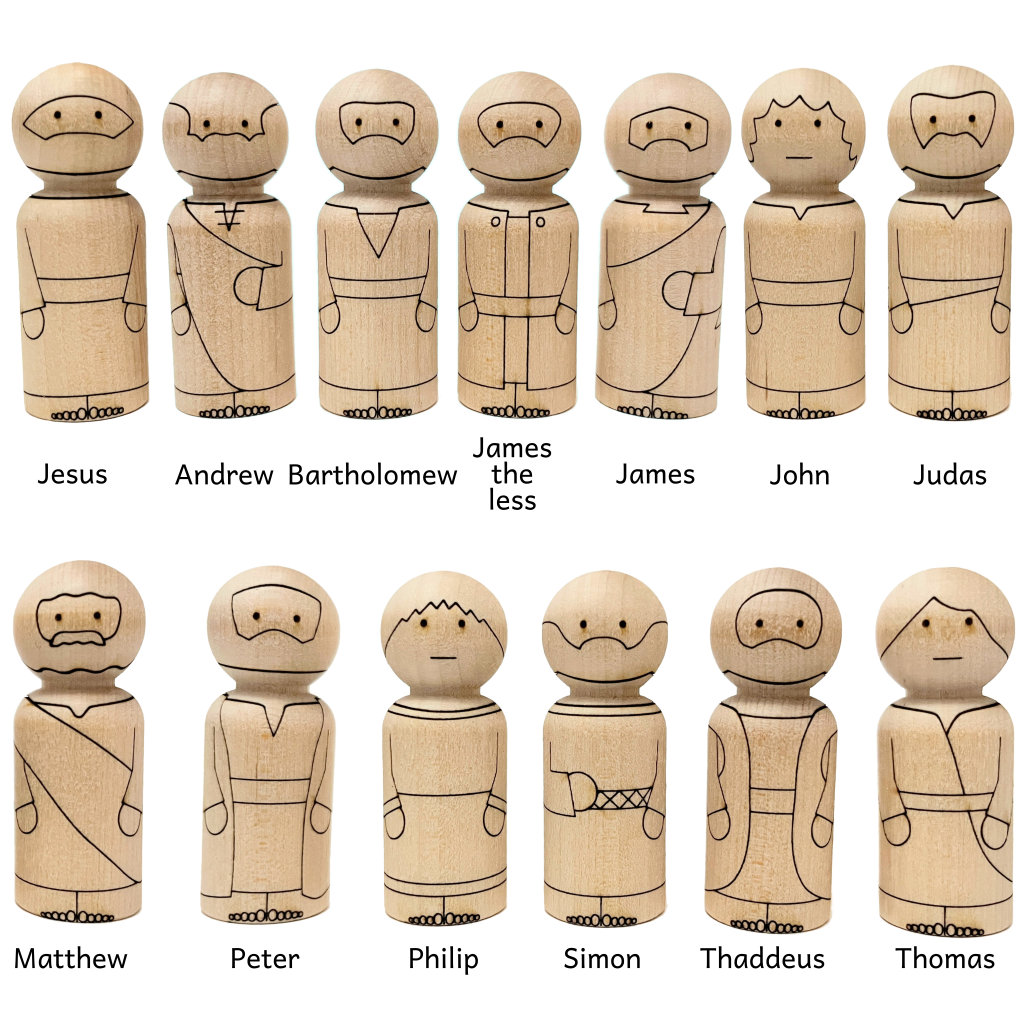
- Welcome the students and introduce the Pegsies Easter Peg Doll Set and Pegsies Last Supper Peg Doll Set.
- Explain that we will be using these sets to help us understand the significance of the Last Supper and the events leading up to the Resurrection.
The Last Supper (15 minutes)
- Read John 13:1-17, where Jesus washes the disciples’ feet.
- Use the Pegsies Last Supper Peg Doll Set to illustrate the different characters and events of the story.
- Ask the students questions about the story and encourage them to share their thoughts and reflections.
Scripture
John 13:1-7 (ICB)
John 13 It was almost time for the Jewish Passover Feast. Jesus knew that it was time for him to leave this world and go back to the Father. He had always loved those who were his own in the world, and he loved them all the way to the end.
2 Jesus and his followers were at the evening meal. The devil had already persuaded Judas Iscariot to turn against Jesus. (Judas was the son of Simon.) 3 Jesus knew that the Father had given him power over everything. He also knew that he had come from God and was going back to God. 4 So during the meal Jesus stood up and took off his outer clothing. Taking a towel, he wrapped it around his waist. 5 Then he poured water into a bowl and began to wash the followers’ feet. He dried them with the towel that was wrapped around him.
6 Jesus came to Simon Peter. But Peter said to Jesus, “Lord, are you going to wash my feet?”
7 Jesus answered, “You don’t understand what I am doing now. But you will understand later.”
https://www.biblegateway.com/passage/?search=John+13&version=ICB
Questions
- Why do you think Jesus chose to wash the disciples’ feet? What do you think he was trying to teach them?
- Why did Peter object to Jesus washing his feet? How do you think Peter felt when Jesus explained why he was doing it?
- How can we follow Jesus’ example of serving others in our own lives? Can you think of any examples of times when you have served someone else?
Jesus’ Betrayal and Arrest (15 minutes)
- Read John 18:1-11, where Jesus is betrayed by Judas and arrested.
- Use the Pegsies Easter Peg Doll Set to illustrate the different characters and events of the story.
- Ask the students questions about the story and encourage them to share their thoughts and reflections.
Scripture
John 18:1-11 (ICB)
John 18 When Jesus finished praying, he left with his followers. They went across the Kidron Valley. On the other side there was a garden of olive trees. Jesus and his followers went there.
2 Judas knew where this place was, because Jesus met there often with his followers. Judas was the one who turned against Jesus. 3 So Judas led a group of soldiers to the garden. Judas also brought some guards from the leading priests and the Pharisees. They were carrying torches, lanterns, and weapons.
4 Jesus knew everything that would happen to him. Jesus went out and asked, “Who is it you are looking for?”
5 The men answered, “Jesus from Nazareth.”
Jesus said, “I am Jesus.” (Judas, the one who turned against Jesus, was standing there with them.) 6 When Jesus said, “I am Jesus,” the men moved back and fell to the ground.
7 Jesus asked them again, “Who is it you are looking for?”
They said, “Jesus of Nazareth.”
8 Jesus said, “I told you that I am he. So if you are looking for me, then let these other men go.” 9 This happened so that the words Jesus said before might come true: “I have not lost any of the men you gave me.”
10 Simon Peter had a sword. He took out the sword and struck the servant of the high priest, cutting off his right ear. (The servant’s name was Malchus.) 11 Jesus said to Peter, “Put your sword back. Shall I not drink of the cup[a] the Father has given me?”
https://www.biblegateway.com/passage/?search=John+18&version=ICB
Questions
- Why did Judas lead a group of soldiers to arrest Jesus? What was their goal?
- Why did Peter try to defend Jesus with a sword? What do you think he was feeling in that moment?
- Why do you think Jesus told Peter to put away his sword and allow himself to be arrested? What does this tell us about Jesus’ character?
The Crucifixion (15 minutes)
- Read John 19:16-30, where Jesus is crucified.
- Use the Pegsies Easter Peg Doll Set to illustrate the different characters and events of the story.
- Ask the students questions about the story and encourage them to share their thoughts and reflections.
Scripture
John 19:16-30 (ICB)
John 19 16 So Pilate gave Jesus to them to be killed on a cross.
The soldiers took charge of Jesus. 17 Carrying his own cross, Jesus went out to a place called The Place of the Skull. (In the Jewish language[b] this place is called Golgotha.) 18 There they nailed Jesus to the cross. They also put two other men on crosses, one on each side of Jesus with Jesus in the middle. 19 Pilate wrote a sign and put it on the cross. It read: “JESUS OF NAZARETH, THE KING OF THE JEWS.” 20 The sign was written in the Jewish language, in Latin, and in Greek. Many of the Jews read the sign, because this place where Jesus was killed was near the city. 21 The leading Jewish priests said to Pilate, “Don’t write, ‘The King of the Jews.’ But write, ‘This man said, I am the King of the Jews.’”
22 Pilate answered, “What I have written, I have written!”
23 After the soldiers nailed Jesus to the cross, they took his clothes. They divided them into four parts. Each soldier got one part. They also took his long shirt. It was all one piece of cloth, woven from top to bottom. 24 So the soldiers said to each other, “We should not tear this into parts. We should throw lots to see who will get it.” This happened to give full meaning to the Scripture:
“They divided my clothes among them.
And they threw lots for my clothing.”So the soldiers did this.
25 Jesus’ mother stood near his cross. His mother’s sister was also standing there, with Mary the wife of Clopas, and Mary Magdalene. 26 Jesus saw his mother. He also saw the follower he loved standing there. He said to his mother, “Dear woman, here is your son.” 27 Then he said to the follower, “Here is your mother.” From that time on, this follower took her to live in his home.
28 After this, Jesus knew that everything had been done. To make the Scripture come true, he said, “I am thirsty.” 29 There was a jar full of vinegar there, so the soldiers soaked a sponge in it. Then they put the sponge on a branch of a hyssop plant and lifted it to Jesus’ mouth. 30 Jesus tasted the vinegar. Then he said, “It is finished.” He bowed his head and died.
https://www.biblegateway.com/passage/?search=John+19&version=ICB
Questions
- Why was Jesus crucified? Who was responsible for his death?
- Why did Jesus say, “It is finished” before he died? What did he mean by this?
- How do you think the disciples felt when they saw Jesus die on the cross? What do you think they did next?
The Resurrection (15 minutes)
- Read John 20:1-20, where Jesus rises from the dead.
- Use the Pegsies Easter Peg Doll Set to illustrate the different characters and events of the story.
- Ask the students questions about the story and encourage them to share their thoughts and reflections.
Scripture
John 20:1-20
John 20 Early on the first day of the week, Mary Magdalene went to the tomb. It was still dark. Mary saw that the large stone had been moved away from the tomb. 2 So Mary ran to Simon Peter and the other follower (the one Jesus loved). Mary said, “They have taken the Lord out of the tomb. We don’t know where they have put him.”
3 So Peter and the other follower started for the tomb. 4 They were both running, but the other follower ran faster than Peter. So the other follower reached the tomb first. 5 He bent down and looked in. He saw the strips of linen cloth lying there, but he did not go in. 6 Then following him came Simon Peter. He went into the tomb and saw the strips of linen lying there. 7 He also saw the cloth that had been around Jesus’ head. The cloth was folded up and laid in a different place from the strips of linen. 8 Then the other follower, who had reached the tomb first, also went in. He saw and believed. 9 (These followers did not yet understand from the Scriptures that Jesus must rise from death.)
10 Then the followers went back home. 11 But Mary stood outside the tomb, crying. While she was still crying, she bent down and looked inside the tomb. 12 She saw two angels dressed in white. They were sitting where Jesus’ body had been, one at the head and one at the feet.
13 They asked her, “Woman, why are you crying?”
She answered, “They have taken away my Lord. I don’t know where they have put him.” 14 When Mary said this, she turned around and saw Jesus standing there. But she did not know that it was Jesus.
15 Jesus asked her, “Woman, why are you crying? Whom are you looking for?”
Mary thought he was the gardener. So she said to him, “Did you take him away, sir? Tell me where you put him, and I will get him.”
16 Jesus said to her, “Mary.”
Mary turned toward Jesus and said in the Jewish language, “Rabboni.” (This means Teacher.)
17 Jesus said to her, “Don’t hold me. I have not yet gone up to the Father. But go to my brothers and tell them this: ‘I am going back to my Father and your Father. I am going back to my God and your God.’”
18 Mary Magdalene went and said to the followers, “I saw the Lord!” And she told them what Jesus had said to her.
19 It was the first day of the week. That evening Jesus’ followers were together. The doors were locked, because they were afraid of the Jews. Then Jesus came and stood among them. He said, “Peace be with you!” 20 After he said this, he showed them his hands and his side. His followers were very happy when they saw the Lord.
https://www.biblegateway.com/passage/?search=John+20&version=ICB
Questions
- Why did Mary Magdalene go to the tomb early in the morning? What did she find when she got there?
- Why did Peter and John run to the tomb after Mary Magdalene told them what she had seen? What did they find when they got there?
- Why do you think Jesus appeared to his disciples after he rose from the dead? What message do you think he wanted to share with them?
Conclusion and Activity (10 minutes)
- Close the lesson in prayer thanking God for sending his Son, Jesus, to die on the cross to forgive our sins and then rise from the dead.
- Provide coloring pages for students to color each of the characters in the Pegsies sets.
- Encourage them to think about the characters and events of the Last Supper and the events leading up to the Resurrection as they color.
- Encourage students to take their coloring pages home and share them with their families to facilitate discussion.
Notes:
- This lesson plan can be adapted for different age groups by adjusting the level of detail in the Bible readings and the questions asked.
- Additional activities or discussions can be included to further engage students with the Last Supper and the events leading up to the Resurrection.

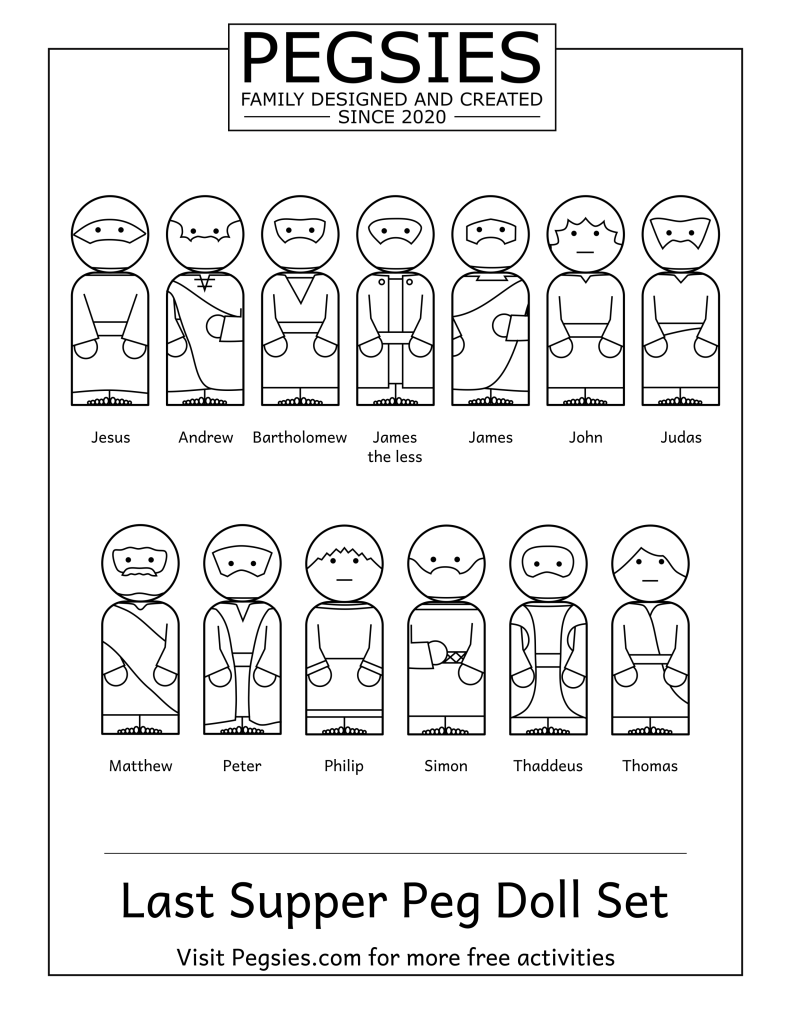
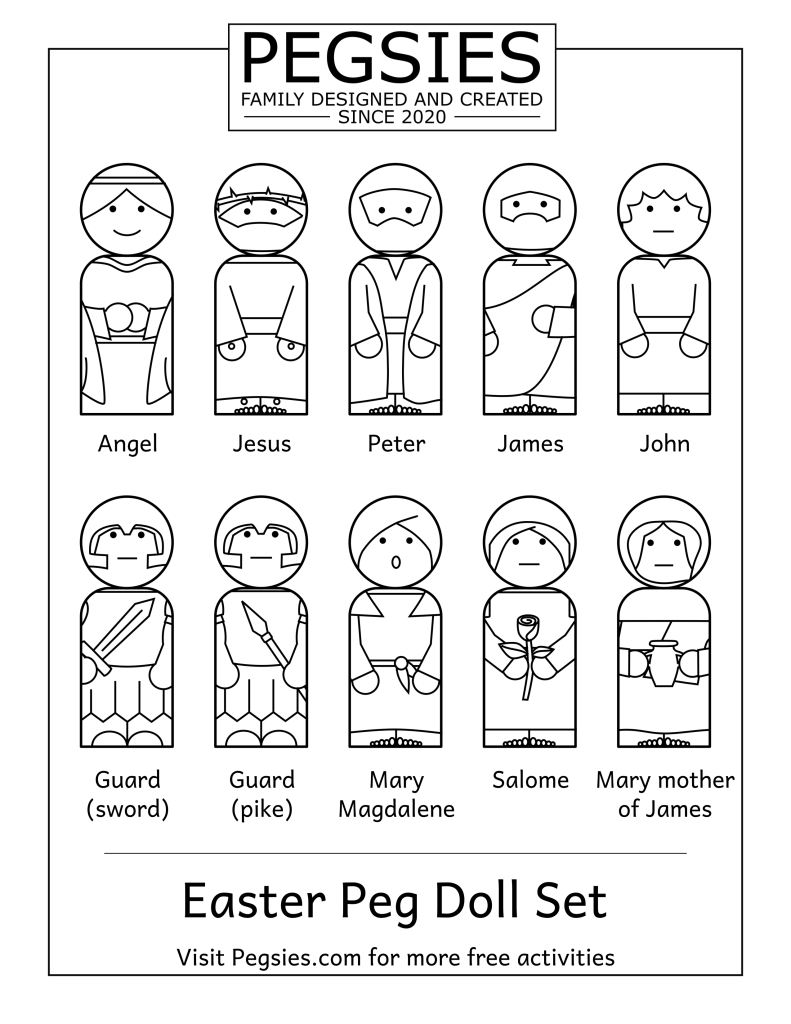

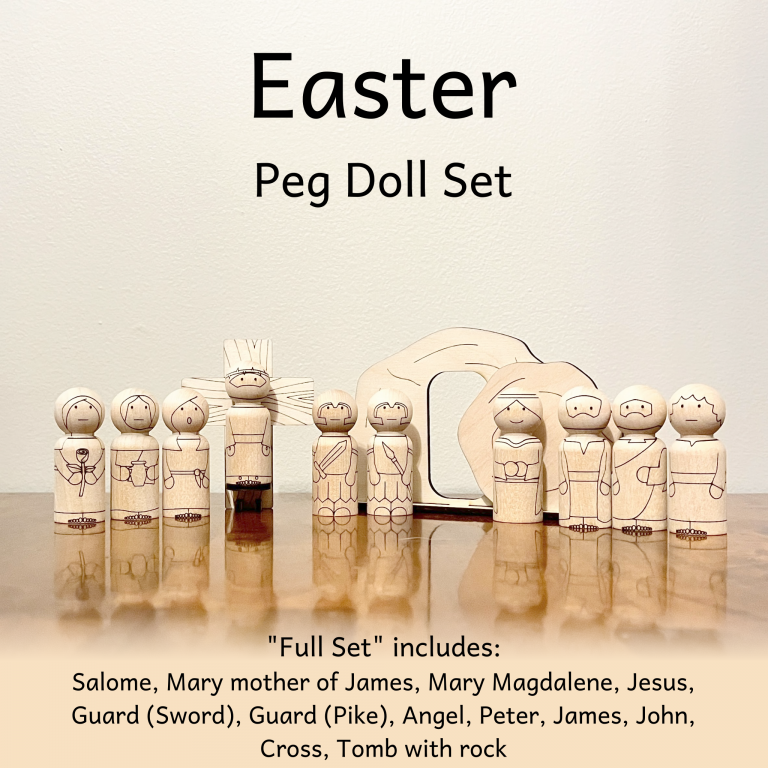
This is so helpful! Thanks. Excited to share this with my kids.